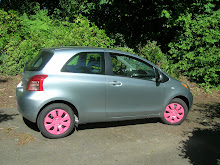Things that make Hindi a strange and difficult language to learn:
- The script is different. Devanagari script (देवनागरी) is actually very phonetic and makes a lot more sense than say, English spelling. I am very comfortable with the letters and can write the script out pretty quickly. When it comes to reading however, having not been raised reading the script, my English-speaking brain still has to sound out every word and reading anything (even whatever it is that I've just written) takes an annoyingly long time.
- Hindi has four different ways of pronouncing the letter that we think of as "T," (त, ट, थ, ठ) none of which are the way we pronounce it. This makes it impossible for us English-speakers to hear the difference between the four sounds or to produce the correct sounds ourselves. All of this also applies to the letter "D."
- All Hindi nouns have genders without any standard gender signifier, thus, one must memorize the gender of every word.
- When it comes to numbers, in English we have a pretty understandable system of twenty + one = twenty-one or fifty + five = fifty-five. In Hindi there's just a separate word for EVERY NUMBER. For example, the word for nine is nau and the word for twenty is bis but the word for twenty-nine is untis. Why?!
- If you want to include a preposition in your sentence, you essentially need to change the whole construction of the sentence. I've tried avoiding ever using prepositions and I've found that doesn't work.
- Perhaps the hardest part of Hindi to grasp is the Yoda-speak sentence order. That is, in English our sentences go Subject-Verb-Object "I read books" and in Hindi it is Subject-Object-Verb "I books read." A sample sentence from my text book is "Every day we meet you in class" which in Hindi is हम रोज़ क्लास में आप से मिलते हैं, which directly translates as "We every day class in you from we meet are." Sentence constructions begin to feel like mathematical equations.
Things that make Hindi fun and adorable:
- Some words must be pronounced more nasally than others. Nasalization can actually change the meaning of a word, so it is important. These nasal sounds combined with the rhythm and intonation necessary for the scrambled-up sentence order makes everyone, in my opinion, sound just a little more like a cartoon character than they do when speaking English.
- In my grammar class we just learned about a whole category of words and phrases that exists in Hindi where one word is either repeated, or repeated with a meaningless rhyming word. For example, if you want to say "tea or something" you can say "chai-vai," or if something is blue you can say it is "nila" and if it is very blue you can say it is "nila-nila."
- There is a separate word in Hindi for every member of one's family, so there is not just "uncle" there is father's older brother, mother's younger brother, etc. Many of these kinship terms tend to be cute-sounding doubled-up words like mentioned above. Your father's brother is your "cha-cha," your wife's brother is your "saalaa," your daughter's son is your "naataa," etc.
- The Hindi word for "finger" is "oongli." This is my new favorite thing to say.
- Knowing Devanagari script gives me a wonderful secret code to write in. I can write, for example, "निकोल इस वैरी अनोयिंग एंड सिल्ली" and Nicole won't even be offended.


Google translate says "Nicole Anoying and blocks the enemy"
ReplyDeleteBablyon.com translation is "The other hostile अनोयिंग & whetstone"
ReplyDeleteIt just sounds like you are really developing a love for the Hindi language and I am assuming having a wonderful time in your classes. What does this mean for the future? mmmm.......How would you say "Stewart can be a very annoying cat" in Hindi?
ReplyDeleteDid you decide on the advanced language class or the beginner one?
ReplyDelete